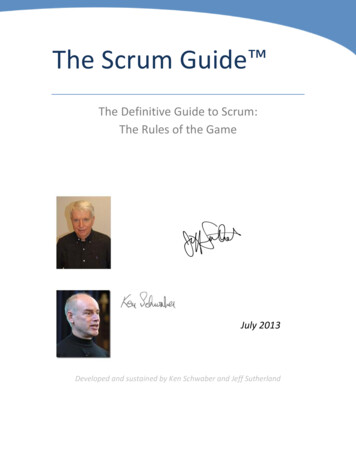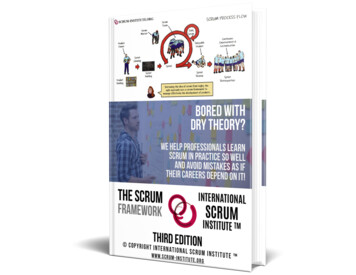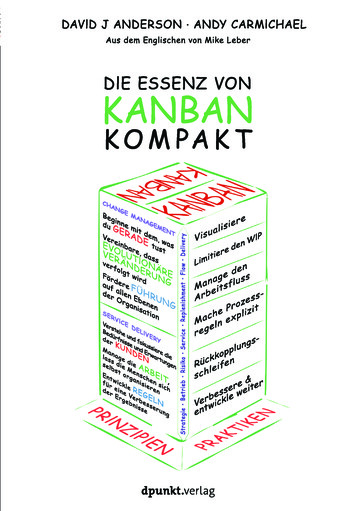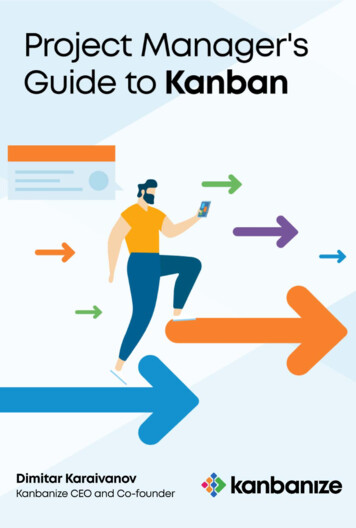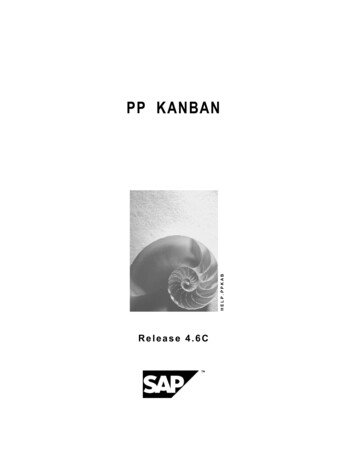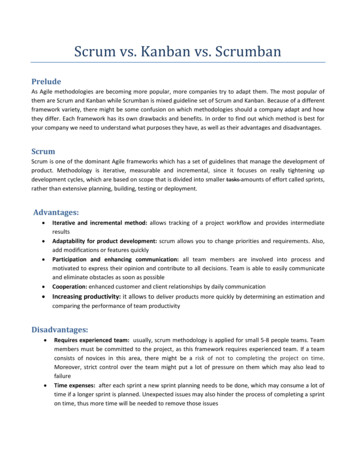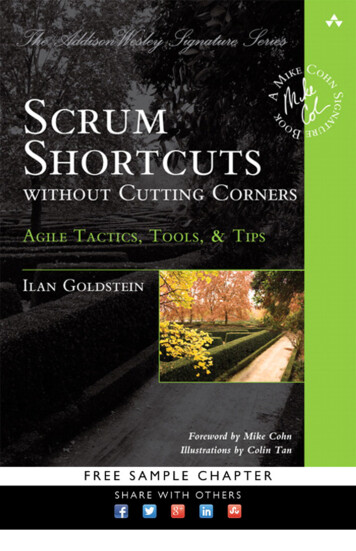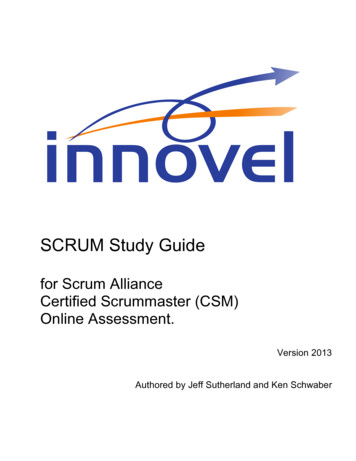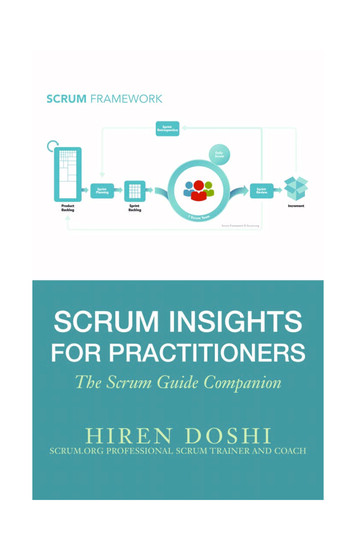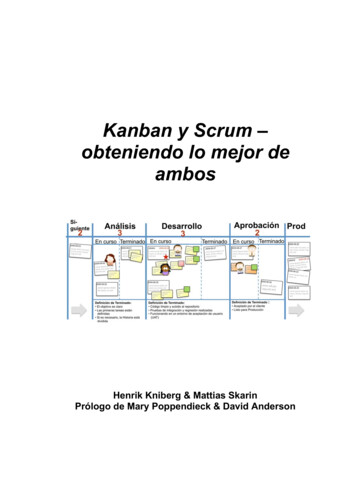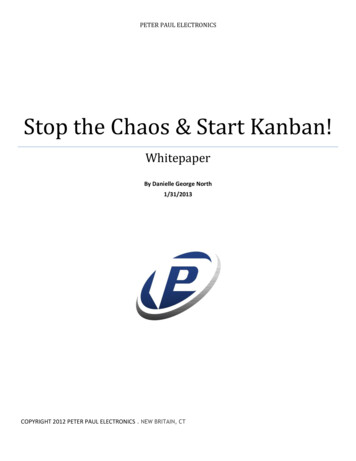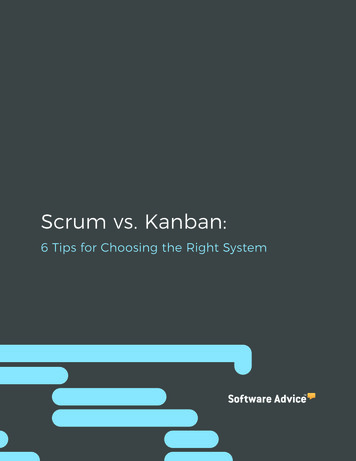
Transcription
Scrum vs. Kanban:6 Tips for Choosing the Right System
Contents3 Introduction4 Tip 1: Start Off Simple5 Tip 2: Analyze Your Team’sWorkflows7 Tip 3: Know Which Methods AreBest For Which Teams11 Tip 4: Assess Purchase Drivers14 Tip 5: Evaluate IntegrationRequirements15 Tip 6: Identify Tools and VetProducts22 Conclusions23 Meet the ExpertsScrum vs. Kanban:6 Tips for Choosing the Right System2
IntroductionScrum and Kanban are two of the most popular project management (PM) methodologiesused by agile teams. Today, many PM software vendors offer products with a rich feature setspecifically designed to help support and structure Scrum and Kanban workflows.Current and prospective agile teams may not know where to begin when choosing PMsoftware. With so many Scrum and Kanban platforms available, it can be hard to knowwhich systems have the capabilities you need.To help narrow your search, Software Advice turned to several industry experts. Using theirguidance, we’ve put together the following tips for selecting Scrum or Kanban software:1. Start Off Simple2. Analyze Your Team’s Workflows3. Know Which Methods Are Best For Which Teams4. Assess Purchase Drivers5. Evaluate Integration Requirements6. Identify Tools and Vet ProductsScrum vs. Kanban:6 Tips for Choosing the Right System3
1: Start Off SimpleExperts agree: The best way to guarantee your agile team stumbles right out of the gate isto implement software before establishing basic workflow processes.Without a solid foundation in place before implementation, teams are likely toadapt their workflows to the software, rather than use it as a tool to help thembecome more efficient and successful.According to Andy Hunt (one of the 17 founders of the Agile Manifesto), the unconstrainednature of any new tool can be a death sentence for an inexperienced agile team.In other words, it’s imperative for a team to start out simple—even if that means usingactual physical tools that have physical limits as the first step in ironing out workflows andfiguring out which processes work and which don’t.“You can only fit so much on a sticky note,you can only fit so much on a whiteboard, ora wall, or whatever physical product you’reusing. There are natural built-in constraints.” Andy Hunt—Author, Publisher, Consultant, ProgrammerOnly once a team has established a solid foundation and understands how to work togetherin the most productive way should managers consider investing in PM software to supportthe team’s workflow processes.Scrum vs. Kanban:6 Tips for Choosing the Right System4
2: Analyze Your Team’s WorkflowsHow developed and structured are your team’s workflows? This question is crucial formanagers considering Kanban and Scrum software solutions.While the Kanban framework is more flexible and doesn’t have formal guidelines in place,the Scrum framework is fairly prescriptive in how teams should set up workflows.As such, managers should question if their team can remain productive while “governing”themselves using Kanban software, or if they need to follow a more rigid guide using Scrumsoftware.Here’s a quick breakdown of the difference between Scrum and Kanban workflows:Scrum Workflows: Scrum teams set up their workflows under a “timebox” approach. Thisinvolves working to meet a strict deadline and then evaluating performance (rather thantaking as much time as needed to work through to completion and then evaluating how longit took).With a timebox approach, Scrum teams break projects down into smaller items, called userstories, that they complete during timed sprints. Sprint progress is tracked on a Scrumboard.(For a detailed description of Scrum, see our guide to essential Scrum functionality.)User stories:Sprints:An overarching project requirementA unit of time given to complete athat teams must complete over theset of tasks. Typically, a sprint iscourse of one iteration, or sprint.two weeks long, although teamsThe requirement is then brokencan vary this time frame from onedown into any tasks, issues or bugsto four weeks to accommodatethat teams must resolve in thetheir workflows.process of completing the story.Scrum vs. Kanban:6 Tips for Choosing the Right System5
Kanban Workflows: Kanban teams have more continuous workflows, where tasks areplaced on a Kanban board in a “to-do” column. A team member then takes ownership of thetask, moving it across the board from “in-progress” to “complete,” at which point they moveon to the next task in the queue.“I find Kanban to be very clean, very simple very light. I have a hard time even sayingthat agile can be/would be bloated, butKanban is really stripped down: [You] havea list of tasks of what [you’re] going to workon next you pull it over, you’re done andthen you move on.” — Bob PaulsenSenior Software Project Manager at The NerderyRather than working on a strict schedule, Kanban teams regulate their workflows using twomethods: Setting Work-in-Progress (WIP) limits Calculating lead and cycle time (the later helps teams evaluate how long it took tocomplete each task)(For a more in-depth description of the Kanban methodology and tools, check out our reporton key Kanban software features.)Work-in-Progress (WIP):Lead and Cycle Time:WIP limits help regulate the flowLead and cycle time diagrams help teamsof tasks along the team’s Kanbanmanage their workflows by measuring theboard by limiting the number oftime from when a task is placed on the boardopen and in-progress items allowedto when the task is completed.for any one team member or“Lead time” begins when the task is placed inworkflow stage.the teams’ queue on the Kanban board andends when the task is completed.“Cycle time” refers to the time spent actuallyworking on an open item until completion.Scrum vs. Kanban:6 Tips for Choosing the Right System6
Key Takeaway for Analyzing WorkflowsIf the team requires a strict sprint-flow to successfully deliver on projects,Scrum software might be the best fit. If the team is more productive whenworking under a continuous flow, managers should consider Kanban software.“I would characterize Kanban as probablydangerous for beginners, something thatonly more experienced teams shouldventure on with. The rhythm and “doneness” of a timeboxed Scrum iteration is aneasier environment to understand workworth for beginning teams.”— Andy HuntAuthor, Publisher, Consultant, Programmer3: Know Which Methods AreBest for Which TeamsDepending on what industry your company is in, some teams are better equipped to followScrum or Kanban principles (and thus use Scrum or Kanban software) than others. Let’stake a closer look:Scrum teams: Scrum works well for teams and industries with definitive work cycles,e.g., those who can plan to execute a certain amount of tasks in a sprint and then work fortwo weeks without changing that plan. Any change mid-sprint would throw off the team’scommitments.Tony Solomita, principal consultant and agile service area lead for Excella Consulting (abusiness management and technology consulting firm) says it is much harder for teams tochange priorities mid-sprint.Scrum vs. Kanban:6 Tips for Choosing the Right System7
This is because Scrum teams forecast what they will get done in two-week cyclesand make commitments based on that plan, so even a small change has a large rippleeffect.Scrum is a popular methodology for software development teams. This is because the strictsprint iterations are conducive to how software is typically developed: an initial planningsession followed by a short release cycle, after which teams receive feedback and plan anyrequired updates/changes for future iterations.“Scrum fits well in software developmentproject companies or shops it’s really wellsuited to that. Every two weeks you do aniteration planning meeting, choose all theuser stories that you’re going to take on inthat two week period of time and then yougo off and work for two weeks.”— Dave WhitePrincipal Consultant for Depth ConsultingDevelopers plan out the stories and tasks they can complete in the course of one sprint(typically a specific feature or functionality of the software), which they deliver to the clientfor review at the end of each sprint.Working in two-week iterations thus allows Scrum teams to deliver completed pieces of aproject more frequently, increasing opportunities for feedback and improvement.“Having a sprint and having a strictdeployment schedule based on yoursprints [where] you can measure velocityworks out best, because the client isseeing deliverable product and you have[velocity] reports to show what we’veworked on and the pace of the team.”— Bob PaulsenSenior Software Project Manager at The NerderyScrum vs. Kanban:6 Tips for Choosing the Right System8
How Scrum software helps: Using backlog tools, teams can plan out the user stories they will complete over thecourse of each sprint. Running burndown and velocity reports helps teams evaluate their performanceover the course of the sprint and the accuracy of their forecast. This helps them keeptrack of how many user stories and/or story points they can reliably expect to completeevery sprint.Kanban teams: Kanban works well for teams who experience frequent change, and thuscannot prevent changes from occurring during a two or four week sprint.“Industry teams who are using Kanban their work doesn’t fall into these iterationplans.”— Dave WhitePrincipal Consultant for Depth ConsultingExcella Consulting’s Solomita says that Kanban works best for fast-paced industries, such asmarketing and communications, because it is more accepting of change and allows teams toefficiently re-prioritize commitments.“From a Kanban perspective, when youhave a backlog that is continually evolvingand you can prioritize on a continual basis,that tends to work really well for marketingand communication teams.”— Tony SolomitaPrincipal Consultant andAgile Service Area Lead, Excella ConsultingScrum vs. Kanban:6 Tips for Choosing the Right System9
How Kanban software helps: Activity streams help teams stay apprised of changing needs and status updates byfacilitating real-time communication among team members. Cumulative flow diagrams help teams identify bottlenecks and project scope changeswhich can affect a project’s timeline.Key Takeaway for Deciding Which Method Is Best for Your TeamIndustry teams that have a definitive start and end date to their work cyclesand that can work on several items at once without altering timelines are likelyto benefit most from Scrum software.Teams that have less defined work cycles, begin and finish work sequentiallyand frequently have to re-prioritize tasks to accommodate changingrequirements are likely better off with Kanban software.“Scrum allows you to determine what you’regoing to fit into your sprint for the next twoor four weeks and then run without change.Kanban allows change to happen.”— Scott CordeiroManaging Director for Eliassen’s agile consulting practiceScrum vs. Kanban:6 Tips for Choosing the Right System10
4: Assess Purchase DriversThe need to meet certain business requirements is typically the biggest driver in leadingteams to look for new software solutions. The most common requirements of a new systemare: It must help the company meet regulatory compliance It must have the ability to create Service Level Agreements (SLAs) It must be able to distribute work to remote teamsHere is how Scrum and/or Kanban software can address these needs:Meet Regulatory ComplianceTeams that seek software to help with compliance often need to establish a permanentrecord, or audit trail, that documents each stage of the project process—something thatcan’t be captured with physical whiteboards or post-it notes.In fact, 45 percent of first-time small business buyers cite the need to increasetransparency as a key driver of their search for new software:Top Purchase Drivers for First-Time Buyers: 2015Source: Project Management Software Small Business Buyer Report - 2015Scrum vs. Kanban:6 Tips for Choosing the Right System11
While both Kanban and Scrum software platforms can help teams meet regulatorycompliance, let’s look at an example of how Scrum software does so:Scrum software can track bugs and issues and document each stage of their resolution.The software focuses on accountability and provides a permanent record of each stage ofissue management.Scrum tools, such as JIRA Software and Pivotal Tracker, are specially designed to help teamswith early detection and resolution of bugs or issues by having teams “review” or “test” awork item before it can be marked as “complete.”Any work item that doesn’t test correctly is flagged for further analysis. These systems willalso differentiate between “open” and “re-opened” tasks or issues, which can help teamsprioritize which issues to address first.Issue tracking, meanwhile, lets teams capture issues, record key information, prioritizeissues for importance, resolve issues and review or test the solution.Ability to Create Service Level Agreements (SLAs)In PM, Service Level Agreements (SLAs) are contracts between the business providing aservice and the customer receiving the end product. An SLA outlines the scope, tentativebudget and timeline required to deliver the completed project to the customer.Due to changing customer requirements (which affect project scope, budget and timeline),SLAs are not fixed promises—they are created to address provisional expectations aroundhow long a project can be expected to take.While both Kanban and Scrum software platforms can help teams create SLAs, let’s look atan example of how Kanban software does so:Kanban software such as Rally (recently acquired by CA Technologies) and LeanKit helpsteams calculate lead and cycle time to determine throughput, which measures the numberof work items a team reliably completes within a specific timeframe.By tracking these metrics, Kanban software can help teams more accurately forecasttimelines for new projects based on the data they’ve gathered from past projects. Thelonger teams use Kanban software to track lead time and cycle time and throughput, themore accurate these predictions will be.This allows project teams and clients to enter into SLAs with confidence, as teams canprovide historical data that backs their initial timeline estimate.Scrum vs. Kanban:6 Tips for Choosing the Right System12
Able to Distribute Work to Remote TeamsBoth Scrum and Kanban software can help managers distribute work to remote teams.According to The Nerdery’s Paulsen, software is helpful for replicating team dynamicacross geographic locations by making it possible to connect users and facilitate real-timecommunication.Within Scrum and Kanban software, remote teams can access a shared, virtual task boardand quickly view the status on an open work item. Communication tools, such as activitystreams, allow workers to receive automatic updates on work items to stay up-to-date onteammates’ activities.Some Scrum and Kanban tools also include built-in time tracking, while others may offertime tracking as an add-on to give managers visibility into the individual performance ofremote workers.In particular, cloud-based tools, such as VersionOne, act as a shared database for projectteams. They help facilitate collaboration and increase transparency (and traceability) amongteam members.TeamRoom view, used for team-level daily execution, in VersionOneScrum vs. Kanban:6 Tips for Choosing the Right System13
5: Evaluate IntegrationRequirementsAn additional purchase consideration is how the new PM platform will integrate with existingtools. For example, Excella Consulting’s Solomita says that for software development, teamswill want a platform that integrates with their current code repository tools (such as Git).Additional integration considerations may include: Communication and collaboration tools, such as Slack Time-tracking tools, such as Hubstaff Customer relationship management (CRM) platforms, such as Salesforce orFreshdeskThe majority of online Scrum and Kanban project management solutions have vast onlinemarketplaces of add-ons and integrations. This allows users to enhance a platform’sfunctionality and configure the tool to their unique needs; which is particularly useful whenteams across horizontal industries use the same tool.Additionally, these vendors often provide an open, publicly available API (applicationprogramming interface), which third-party developers can build applications upon tofurther customize the platform according to the needs of vertical industries.Rather than using siloed, industry-specific tools, this allows users to extend the reach andcapabilities of their PM platform and ensure that each extension is synchronized with themain tool.API (application programming interface)An open API provides developers access to allowproprietary technologies to interface and share datawith each other.Scrum vs. Kanban:6 Tips for Choosing the Right System14
6: Identify Tools and Vet ProductsAt this final stage, managers should have a pretty good idea as to which type of software isthe best fit for their team. The next step is to take a closer look at the platforms that offerthe capabilities that best meet their team’s needs.1. Identify ToolsThe following product descriptions provide a more in-depth review of the Scrum and Kanbanproject management tools mentioned in the previous sections.JIRA SoftwareRelease Section in JIRA SoftwarePrice: (Free 7-day trial)Deployment: Cloud-based, On-premiseSize of Business Served: S, M, LScrum vs. Kanban Support: JIRA Software supports both Scrum and Kanbancapabilities. Features include Scrum Boards, Kanban boards, burndown charts,product backlogs, issue management, lead and cycle time calculations and more.Scrum vs. Kanban:6 Tips for Choosing the Right System15
Pivotal TrackerMultiproject workspace in Pivotal TrackerPrice: (Free for up to 3 users)Deployment: Cloud-basedSize of Business Served: S, M, LScrum vs. Kanban Support: Although not a self-proclaimed Scrum solution,Pivotal Tracker includes several capabilities common in Scrum tools, such as theability to create stories and calculate story points as well as team velocity. Userscan also prioritize backlog items and track essential milestones.Scrum vs. Kanban:6 Tips for Choosing the Right System16
RallyReports screen in Rally (now CA Technologies)Price: (Free for up to 10 users)Deployment: Cloud-basedSize of Business Served: S, M, LScrum vs. Kanban Support: Rally supports both Scrum and Kanbancapabilities. With Rally, teams can choose between timebox planning andtracking (Scrum) as well as flow-based planning and tracking (Kanban). Teamscan measure progress via burndown charts or cumulative flow diagrams and canmeasure cycle time and throughput.Scrum vs. Kanban:6 Tips for Choosing the Right System17
LeanKitKanban board in LeanKitPrice: (Free 30 day trial)Deployment: Cloud-basedSize of Business Served: S, M, LScrum vs. Kanban Support: LeanKit adheres to Kanban’s historical backgroundin lean manufacturing and principles, and supports Kanban workflows withfeatures such as Kanban boards, WIP limits and reporting on metrics such aslead and cycle time.Scrum vs. Kanban:6 Tips for Choosing the Right System18
VersionOnePlanningRoom view (used for higher level program and portfolio planning)in VersionOnePrice: (single-team edition is free)Deployment: Cloud-basedSize of Business Served: S, M, LScrum vs. Kanban Support: VersionOne is a solution that fully supportsScrum and Kanban capabilities. The platform can scale to all three levels ofenterprise agile PM, from team to program to portfolio, according to the needsof each organization. Features include Scrum and Kanban task boards, issuemanagement, burndown and velocity reports as well as workitem cycle timereports.Scrum vs. Kanban:6 Tips for Choosing the Right System19
2. Vet ProductsThe tools listed above are just a few examples of the many products available to agileteams. Once teams have their shortlist of Kanban and/or Scrum project managementsolutions, they should demo each and every one.These demos should provide teams with an overview of the software’s interface and allavailable features, which can give teams a feel for the product’s ease of use.Additionally, teams should read reviews about the products they’re interested in to learnwhat other customers have to say about these products when it comes to things such asease of use and support options.Finally, as most vendors will offer either a free starter package or a free trial period, teamsare encouraged to try out several products to ensure the system they choose aligns withestablished workflows and supports their industry needs and team requirements.It’s especially critical that the team demoing, trialing and evaluating the product’sfeatures and ease of use is the team that will actually be using the tool. The needsof every team will vary, so a tool that works well for one team may not support the needs ofanother.“A common problem is over-tooling .[Make] sure that the people who will bedoing the hands-on, day-to-day use of thetool are the ones involved with choosing it.”— Scott CordeiroManaging Director forEliassen’s agile consulting practiceScrum vs. Kanban:6 Tips for Choosing the Right System20
This also helps ensure that teams select a tool with a feature set representative of what theyneed at the time. Flexibility and scalability is important, but teams should only purchase asystem that has the features they will use.“You don’t want to kill a fly with asledgehammer Let the teams pick thedepth of functionality they need.”— Tony SolomitaPrincipal Consultant andAgile Service Area Lead, Excella ConsultingTo make this decision easier, the pricing model and tiered feature set of many cloud-basedsystems mirrors how teams should approach tool selection: only purchase what you neednow, then get feedback from your team and re-evaluate needs as they change over time.“Don’t just get the first vendor’s tool thatlooks good. Get three on a trial, test eachone out, get feedback and see which oneactually works for you The fundamentalpremise of agile is to inspect and adapt.To do something, to get feedback, tochange what you’re doing and to beresponsive. To be agile. That’s where wecame up with the word!”— Andy HuntAuthor, Publisher, Consultant, ProgrammerScrum vs. Kanban:6 Tips for Choosing the Right System21
ConclusionsBuyers in search of Kanban or Scrum project management solutions have several variablesthat factor into their software selection process. To quickly recap, tips for choosing the rightsystem include: Start simple and establish basic processes first. Learn what your team needsbefore introducing a PM solution into the mix. Identify workflow and industry-related influences. Be aware of any specific featureor compliance requirements that may impact software selection. Stay agile! Continue to demo products, ask for feedback and re-evaluate needs as yourteam evolves. If a product isn’t working out, don’t be afraid to search for a new one.For even more help with the software selection process, simply contact one of SoftwareAdvice’s trusted PM advisors. In one short phone consultation, our project managementexperts can help you evaluate your needs and narrow your search for the right solution.For your free consultation, call (888) 918-2745.Scrum vs. Kanban:6 Tips for Choosing the Right System22
Meet the ExpertsAndy Hunt is an established author, publisher, consultant andprogrammer. As one of the 17 founders of the Agile Manifesto andco-author of The Pragmatic Programmer (just two among manyof the publications he has authored/co-authored), Hunt is a wellregarded expert on the subject of agile management and softwaredevelopment. Hunt also writes a popular, self-titled blog, /\ndy,where he discusses how the agile movement has evolved and whereit is headed.Bob Paulsen is a senior software project manager and team lead atThe Nerdery (a custom software design and development company),where he is an advocate for agile management. Paulsen has handson, day-to-day knowledge of both Kanban and Scrum methodologyand software and has managed teams using both methods.Dave White is a principal consultant at Depth Consulting Ltd. (aconsulting firm specializing in agile software development and ITpractices). White began his career as a developer and has over15 years experience in the IT Industry. Now, as an Agile/Kanbanpractitioner, White coaches and teaches around North America.White also authors a popular industry-blog, Agile Ramblings, wherehe discusses Agile, Lean and Kanban leadership.Scott Cordeiro is the managing director for agile consultingservices at Eliassen Group (a technology staffing and consultingservices firm). With over 20 years experience in the IT staffingindustry, Cordeiro leads Eliassen’s agile practice by providing team,portfolio and enterprise level coaching and support for clientslooking to adopt agile practices into their operations.Tony Solomita is principal consultant and agile service area leadfor Excella Consulting (an agile IT consultancy based in Washington,D.C.). Solomita has over 15 years consulting experience and holdsseveral certifications (including both Certified Scrum Professionaland Certified ScrumMaster) and leads the DC Chapter of the AgileLeadership Network (ALN).Scrum vs. Kanban:6 Tips for Choosing the Right System23
Created by:EileenO’LoughlinEileen O’Loughlin is a MarketResearch Associate at SoftwareAdvice. She joined the team in 2015and covers the accounting, projectmanagement and legal managementmarkets.Software Advice profileeileen@softwareadvice.com(512) 375-4071Find me on:
Assembled by:In just fifteen minutes, the experts atSoftware AdviceTM is a trusted resourceSoftware Advice can help you narrowfor software buyers. We provide detaileddown the right software for yourreviews and research on thousandsorganization.of software applications. Our team ofsoftware advisors provides free telephone(888) 918-2748consultations to help buyers build ashortlist of systems that will meet theirneeds.Compare ProjectManagement SoftwareSoftware Advice is a Gartner company.Gartner (NYSE: IT) is the world’s leadinginformation technology research andadvisory company.
Scrum vs. Kanban: 6 Tips for Choosing the Right System Introduction Scrum and Kanban are two of the most popular project management (PM) methodologies used by agile teams. Today, many PM software vendors offer products with a rich feature set specifically designed to help support a
